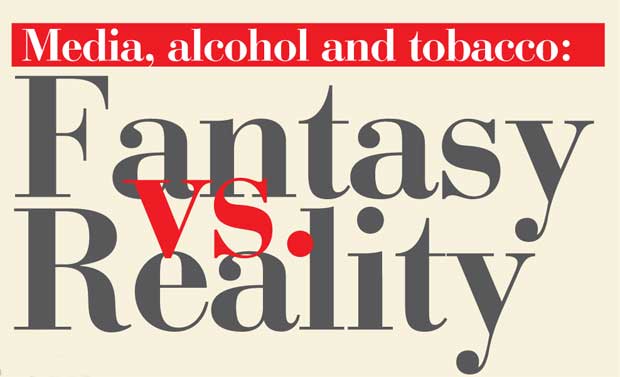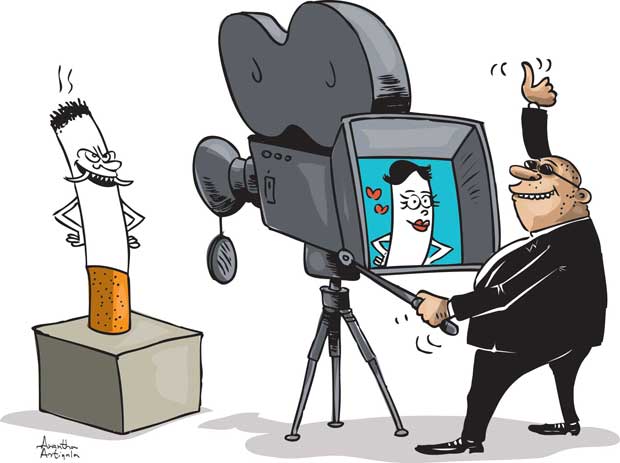Reply To:
Name - Reply Comment
Last Updated : 2024-04-23 20:04:00

If one argues that the advertisement is meant to appeal for the customer and portray alcohol in an attractive manner but the film does neither, then this amounts to deception and self deception. Any film director would tell us that his intention was to talk to the emotions of the viewer as well as to the intellect (and give a message!). A good director will make sure that each tiny bit of the film does exactly that and contribute to the whole of the film. Hence, each second counts and millisecond as well. From moment to moment there is a message delivered. Hence each scene contributes. People engaged in producing anything which has alcohol and tobacco scenes have argued that showing the ‘bad effects’ of them is vital in the education of the general public and they are doing just that. Take the situation where smoking or alcohol is shown throughout the film. Usually the lead characters will be shown using these. Or a tele-drama which depicts alcohol and tobacco in a very attractive, glamorous and aggrandized manner throughout and at the last scene shows that the protagonist dies or some similar mishap takes place. The heavy dose of attraction that is provided during the whole of screening can never be negated by showing the ‘bad effect’ at last and ‘give a message’ to the audience at the end. The message is already given by then. Not once, but several times. Not directly but indirectly, yet extremely effectively. The counter point was driven to the heads of the viewers continually. And what are the effects usually shown as ‘bad consequences’? Whatever it is, the viewer had already got the message that ‘alcohol was something enjoyed by the actor himself’. The purported message is an utter lie compared to what is actually delivered. This cannot be a mistake of directing in most cases.
This form of “education” has been definitely planned to increase the take up of such habits by the next generation of users. More than the good or the bad effects shown, what matters is generally showing these scenes. They are placed in media to normalise and naturalise the use. Such deliberate moves are fortunately reducing due to public protest everywhere in the world.
The danger lies not only in ‘normalisation and naturalisation’ but outright lying. Promotion of myths related to alcohol. One such myth is that alcohol changes behaviour. It does only in circumstances where it is allowed to change, and cannot be described by the chemical effect at all. The man who gets drunk will behave according to the provisions of the environment. For example, no man who carries on an affair with another women will divulge the fact to his wife, however much he is drunk. And hardly ever any village folk, who’s drunk would try to attack a policeman (yes, of course, if one is more powerful than a constable, say a son of a powerful minister, one would do that). One common argument against the banning such portrayal is that there is no cause-effect relationship established. Sounds very familiar as this was the very argument brought forward by the tobacco industry in relation to smoking and cancer decades back. But there is solid evidence to show that there is a very significant association between adolescent drinking and exposure to drinking scenes in films. The research by Collin and others which appeared in the journal of Adolescent Health found that the early exposure predicted early initiation and increase in intention to drink. (Collins, Ellickson, McCaffrey, & Hambarsoomians, 2007).

Even if a brand is not promoted, when it comes to alcohol, tobacco and fast foods, overall attitudes and behavioural change towards positive end of the spectrum takes place in relation to what is portrayed in media. This is not something to do with an argument on marketing but health of the future generation of the world. This is serious.
Hence, the more ‘alcohol scenes’ in the media the higher the tendency of the young to drink as studies clearly show that intention to drink increases after viewing such scenes. This is directly due to glamourisation of drinking and promoting the social acceptance of intoxication as an excuse for many unwarranted behaviours, (in which some of us would want to engage in but not do want to take the responsibility for)rather than the actual chemical effect of alcohol. Just showing a lead character holding a bottle or a glass is good enough advertising.
All reporting is creative and all creativity may contain a grain of truth (or untruth for that matter). There is no escape from either. However, where effects are known, it would not only be sensible, but also be reasonable to keep some subjects away from media. Alcohol is one such subject and suicides is the other. More the exposure, higher the risk of indulging in these by the young. As I have mentioned earlier, it is not just the bad or the good of the way of reporting; mere availability of these items in news contributes in an unhealthy manner to our society. This is multiplied currently due to the use of attractive flowery language that the newscasts use today. They continue to engage in crime of aggrandising, glorifying as well as normalisation and generalisation of these phenomena under the pretence of rights of the viewer or the listener to know the truth. What ‘truth’ is the question? Mostly the edited, filtered and manipulated truth in order to manufacture consent.
Is it the most defining characteristic of the lead character to smoke or drink. If one googles for pictures, one sees “Che” smoking a cigar. Is it the most revolutionary characteristic of Che to smoke a cigar? What proportion of aesthetic quality would be lost if Che were to be portrayed without a cigar at hand?
Compare this with sex. Most films, even if produced for an adult audience, will touch upon the subject of family life without even showing a single scene which contain
explicit (sexual) material.
Why do the film makers then argue on inclusion of drinking (or intoxicated or any behavioural accompaniment including discussing alcohol)? They can’t be such incapable.
Historically there was a reasonable concern that the aesthetics and effectiveness of a production was  affected due to sudden implementation of ban on alcohol scenes. Then the authorities resorted blurring of these and then to editing out. But that was history. That was and era when the influence of alcohol scenes on children were not discussed yet in the field of film production. Later the TV show makers and film editors could come out with very successful productions without inclusion of such scenes and the field moved forward by acknowledging this as part of its social responsibility. I repeat it. The fields of film making and Tele-drama in fact, moved forward by learning the fact that showing tobacco-alcohol scenes are harmful and creatively dropping out such scenes. The sporadic cases which we see now and then raises the suspicious of being directly or indirectly influenced by the industry.
affected due to sudden implementation of ban on alcohol scenes. Then the authorities resorted blurring of these and then to editing out. But that was history. That was and era when the influence of alcohol scenes on children were not discussed yet in the field of film production. Later the TV show makers and film editors could come out with very successful productions without inclusion of such scenes and the field moved forward by acknowledging this as part of its social responsibility. I repeat it. The fields of film making and Tele-drama in fact, moved forward by learning the fact that showing tobacco-alcohol scenes are harmful and creatively dropping out such scenes. The sporadic cases which we see now and then raises the suspicious of being directly or indirectly influenced by the industry.
Films and tele-dramas are not the only methods of non-advertised promotion that are used in the industry. Apart from the rest, one important aspect gets precedence. That is the research and related field that is supported and sometimes maintained by the industry itself. For example, web sites which are dedicated to discuss scientific studies in alcohol are know to run by the industry itself.
Industry sponsored studies are biased. There is a heap of industry supported websites, journals and ‘academic organisations’ as well as researchers who carry out research for the industry.
It is worthwhile to recall that the need for differentiation of so called ‘evidence’ is a must. It is not so difficult to identify such articles and websites. Even if the content appear to be the same, the way the things are put forward differs a lot. The generalisation, normalisation and glamorisation are subtly visible in all the articles or disguised to the extent to which an unsuspecting reader is cleverly deceived
The frequently appearing phrases in such articles would include the following; ...Drinking is considered cool by many college students, ...alcohol is a popular drink, ...they use beer to cope with stress of college life and …there will not be support from the public for such a policy etc...And included that the evidence is controversial etc...They may promote measures which are not effective: e.g. educate the young on effects (read as biological effect of alcohol, i.e. cirrhosis) and occasionally psychological (read as violence, loss of memory and being not responsible for one’s actions when drunk). But would never educate on the actual effects. The actual effects of alcohol include impotence and permanent brain damage in the long run. And purported memory loss, behavioural change and ‘fun’ depend on the environment and does not correlated with actual chemical effect.
What next? The danger is that the artists’ community would take this message as directed against them. It is never the case and it will be never. The issues is that a multi-billion dollar industry has used the creativity of the youth to achieve its means by inculcating the attitudes; it has made this appear as a war against aesthetics and liberty. The simple question that I have to ask is where do everyone gets the idea of “smoking is fun?” All of us were victims of decades, if not century or two, of promotion of tobacco and alcohol by the industry (and addicted individuals who have to justify (or for that matter self-justify) their habit. We will find it very difficult to challenge our own beliefs and attitudes towards perceived ‘correct’ experiences, yet that is where the progress lies.
To sum up, I would like to emphasise on the fact that, alcohol and tobacco depicted current media, continues to promote these in our society. We ourselves are a generation who were victims of promotion by the industry and would find it difficult to appreciate that fact, as we ourselves are made to think these as ‘normal, general, day-to-day phenomena. Science clearly shows that alcohol and tobacco scenes are contributing to taking up the habits by the young generation. World over, health authorities want the governments to regulate media in this respect and request the artists to contribute to war against these two massive public health hazards.

Add comment
Comments will be edited (grammar, spelling and slang) and authorized at the discretion of Daily Mirror online. The website also has the right not to publish selected comments.
Reply To:
Name - Reply Comment
On March 26, a couple arriving from Thailand was arrested with 88 live animal
According to villagers from Naula-Moragolla out of 105 families 80 can afford
Is the situation in Sri Lanka so grim that locals harbour hope that they coul
A recent post on social media revealed that three purple-faced langurs near t